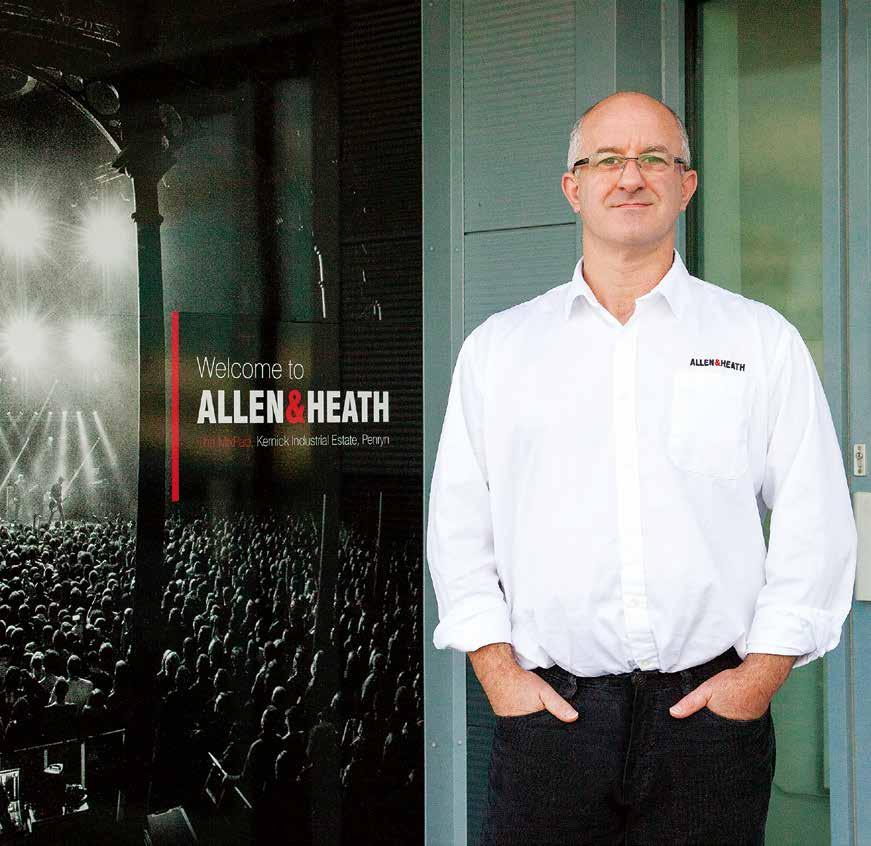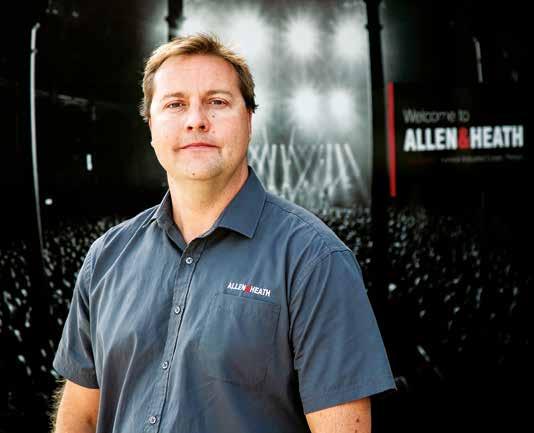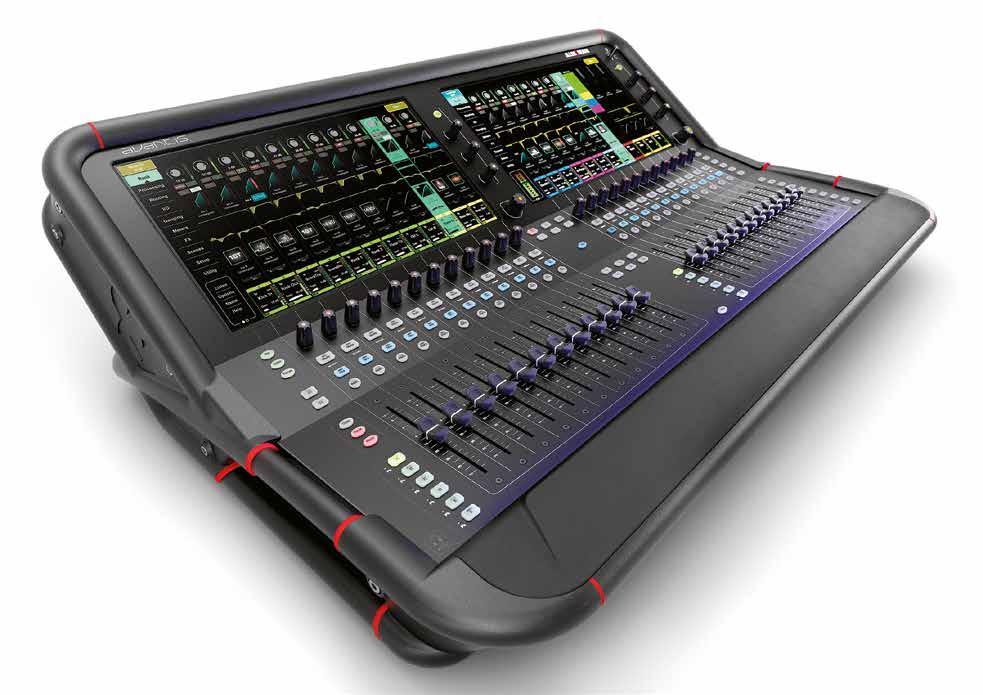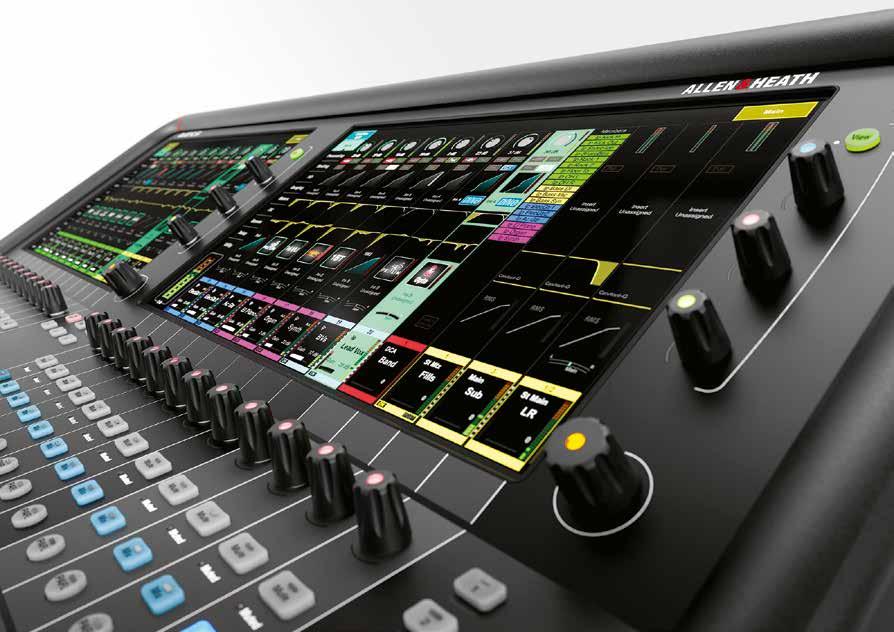
10 minute read
Filling the gap
Richard Lawn travels to Cornwall to meet Allen & Heath’s new digital console, Avantis

Managing director Rob Clark
Celebrating its 50th anniversary in 2019, Allen & Heath marked a distinguished half-century in the entertainment technology industry with a notable product launch. As an early pioneer of analogue mixers, the company began its digital journey in the mid-1990s.
By focusing on affordable, quality audio without sacrificing performance, the brand found a successful gap in the market and has since gained increasing recognition as a pioneer of digital console technology.

R&D director Andy Bell
Following several changes in ownership over its long history, Allen & Heath is now under the stewardship of Audiotonix alongside Calrec, DiGiCo and Solid State Logic, making it well poised to meet the challenges of the next half-century. Having significantly invested in its Cornish R&D team, Allen & Heath continues to listen to its growing database of users by developing products with a ready-made market. Its third 96kHz digital mixer, Avantis, is a 64-channel/42 configurable bus console with twin full HD touchscreens, extensive I/O options and processing from the company’s flagship dLive mixing system.

Product manager Nic Beretta
Remarkably, the console’s origins only date back to early 2017, when managing director Rob Clark threw down the gauntlet to R&D director Andy Bell to plug the gap between the successful dLive and SQ platforms. ‘At the outset, the internal development name for this project was “Bridge”,’ explains Bell. ‘We knew from our customers exactly what was needed – a console that could handle higher channel and mix counts than SQ but was accessible at a lower price point than dLive.
‘Meeting one of those criteria would be simple, but meeting both would not. So, I started sketching out different concepts, trying to find a winning formula. The first key decision was to integrate the I/O and processing in a single unit, which immediately sets it apart from dLive, which has a more flexible, mix ‘n’ match architecture. Initially, Avantis took a lot of inspiration from SQ but, as we got further into new ideas such as screen integration along the bottom edge and the channel strips migrating onto the glass, it rapidly took on an identity of its own.’
The first simple 3D creative of Avantis was a 1:1 cardboard model with printed graphics glued to its exterior. This visual basis allowed the extensive R&D team to add their input into the initial design. Of the 55 engineers in the department, 20–25 of them worked on the Avantis project. ‘The team got around it and knocked the corners off it,’ recalls Bell. ‘They were asking: “where does this button go?” or “how do I get that feature?” So even before anything had been built, we were trying to balance economics with materials and to stimulate new creative ideas.’
Input was also received from working audio engineers throughout the process. ‘Every detail was discussed and challenged along the way as we advanced through increasingly sophisticated prototypes,’ continues Bell. ‘The decision to substitute a normal rugged plastic with the diecast metal chassis that is a distinctive feature of Avantis was made very early on. So it was a journey, which it always is, but we’ve ended up with a console that is close to what was initially intended, despite a few wrong turns along the way.’
Allen & Heath has made much of the technology platform underlying its current generation of 96kHz digital consoles. First seen in its dLive series and later miniatured for use in SQ, Avantis is the third mixer to benefit from the company’s XCVI FPGA core. ‘Console designs previously incorporated a number of discreet chips, each one processing eight channels of audio with a number of limitations,’ explains product manager, Nic Beretta. ‘Now, it’s all integrated into a single FPGA core, for which the single chip is pretty much the size of a stamp.
Yet it’s incredibly powerful, providing dLive and Avantis with an ability to mix all the input channel counts and all the processing with only 0.7ms of system latency from input to output. I don’t think there’s another competitive console on the market that can achieve this with the same amount of processing. In addition, all the mix outputs are phase coherent, regardless of the path that you take internally in the console.’

Encased in its alloy shell and tubular frame, the Avantis control surface is centred on two full HD touchscreens with corresponding rotary controls. ‘Having two touchscreens isn’t a new concept, but we realised we could use it to unlock exciting new possibilities,’ explains Bell.
‘This led us to develop the Continuity UI. Within seconds of getting hands-on with Avantis, engineers appreciate the seamless flow between the physical controls and the on-screen software. You can work gains and pans on the rotaries, then, at the touch of a soft key, switch to EQ or dynamics across the whole strip.
The console also provides a highly configurable FastGrab tab on the right-hand side of each screen, offering another way to quickly and easily access control of aux sends, EQ, compressor and FX on the currently selected channel or spot channel. With Continuity UI, the user decides how they’d like to work – not the mixer.’ For a digital console to make its mark, intuitive features are a prerequisite. ‘ Upon their first inspection of Avantis, engineers often ask where the select key has gone,’
Within the Allen & Heath R&D labyrinth, several testing rooms pose as torture chambers for those parts auditioning for a lead role in future console designs. Here, the components including the touchscreens are subjected to real-world tests for long periods, including dust, sand, heat, humidity, sticky liquids, fizzy drinks, vibrations and drop tests. ‘Over the past few years, we’ve started simulating touring abuse and anything that will end up at some stage within a console chassis. As a result, we are confident that the consoles are reliable and fit for purpose. You don’t expect the customers to drop a console, but you need to develop a good stress test for such an eventuality.’

Bell continues. ‘However, within two minutes, they realise it’s all within the touchscreen user interfaces, where you can do so much more. It’s extremely intuitive with pre-post switching, safes and freeze layers in Continuity UI, and the large symbols indicate whether it is locked or unlocked. The large proportion of touchscreen real estate created many challenges for us, such as stress testing the glass. We spent a lot of time sourcing the right products from the right component manufacturers to ensure it’s reliable.’
Given the vertical market sectors that Avantis aims to penetrate, flexibility is paramount. While many users will choose to pair Avantis with the 48-in/16-out GX4816 audio expander, Avantis is also part of Allen & Heath’s Everything I/O ecosystem. This allows an operator wishing to build a compact system or a rental company with existing Allen & Heath stock to connect to a large range of audio expander hardware. Avantis is also compatible with the ME personal mixers and IP hardware remote controllers.
For local I/O, Avantis is equipped with 12 XLR analogue inputs, 12 XLR analogue outputs plus AES (stereo in and dual stereo out). ‘Everything I/O is a concept we’re fully committed to,’ explains Bell. ‘If a customer already has Allen & Heath I/O boxes such as the AR2412 and AR84, we want them to have the option of using these with Avantis. Equally, with portable expanders like the DX168, they can easily add more I/O wherever it’s required, or maybe they need the output-only DX012. Altogether, there are 10 different compatible I/O boxes, including wall-mount I/O for installs, which gives Avantis a great deal of flexibility.’
With the integration of the S-Link port on the rear, users can access the full range of audio expanders and system solutions including the ME1, ME500 and ME-U hub from the ME personal monitoring suite. With the addition of two additional I/O ports, each capable of providing 128 bidirectional channels at 96kHz, Avantis can draw on a full range of current dLive option cards. Further expanding the scope for system integration, FOH/monitor splits and multitrack recording, popular dLive cards include Dante (64x64 and 128x128), Waves, gigaACE and superMADI.
Avantis incorporates processing tools including compressors, EQs and the Cornish innovator’s RackExtra FX units with 12 slots. The optional upgrade to dPack expands Avantis further with additional dLive processing including the Dyn8 dynamics engine, DEEP compressors and the Dual-Stage Valve preamp. For a one-off payment, dPack purchasers automatically receive all future DEEP and FX updates free of charge.
Differentiating Avantis from SQ and dLive, the dPack element of Avantis took a long time for the software engineers to conceptualise, Bell admits. ‘All these tools are included as standard with our flagship dLive systems, while on SQ the user can buy individual add-ons. For Avantis, we’re offering the convenience of a one-time key for access to all the additional processing.’
The fact that the head mechanical engineer at the company was previously an army tank commander goes some way to explaining why Avantis further distinguishes itself from the pack with its all-metal chassis frame. ‘Avantis is encased within a super-strong tubular frame, or exoskeleton, and a die-cast chassis,’ Bell continues. ‘That gives it a lot of rigidity during transport, while adding a very dynamic, distinctive aesthetic look. Not only does it look stunning but I feel the time has arrived to depart from plastic, which is becoming a relevant environmental topic. The market may be used to plastic, but there is a lot of negativity surrounding it. This is our opportunity to replace plastic with something that is stronger and more durable.’
As any R&D director will testify, bridging the gap is one of the trickiest acts to balance. ‘The mission from the outset was to breathe some excitement into the 64-channel mixer space, which is littered with 48kHz old-school consoles,’ says Bell. ‘In many ways, maybe it would’ve been easier to create a scaled-down dLive or scaled-up SQ to fill this space, but the more we examined what customers were looking for in this area, the more certain we became that we needed a new solution. Avantis brings next-generation performance across the board. Technicians in venues, houses of worship, touring and the rental market are going to be seriously impressed by how well this ticks the boxes. It’s a really exciting mixer at a compelling price.’
Tasked with advancing sales of Avantis, Beretta applauds how the in-house engineers managed to complete the two-year tightrope challenge. ‘In terms of the key differences, we see dLive as a much more flexible distributed system. dLive is not only more scalable in terms of inputs, outputs, channel count and bus count, but also in terms of the distribution of different processing and control elements where you can mix with or without a control surface.
With dLive, you can mix and match from a range of seven different rack engines and six different surfaces and then start building a system around them with controllers, GPIO interfaces and networking cards. Avantis distinguishes itself more as a standalone mixing console. By incorporating the mix engine and the control elements together with the XCVI core, Avantis fits the classic FOH, monitor or broadcast mixing application perfectly.’

Looking back over the two-year Avantis journey, Bell recalls when those first concept sketches took on life. ‘Continuity UI was central to the design but, as it was all on paper, I was anxious as to whether it was going to work. We were attempting to create a seamless blend between what you see on the screen and the physical controls. I was sitting there looking at it on paper, worrying if our users were going to understand this. When we first powered it up, I could see it all come together on the display. It worked, and served as one of those moments when you realise that you’re on the right track.’
With that flicker of electrical energy sparking up the twin 15.6-inch touchscreens, the bridge had been built, the gap filled.










